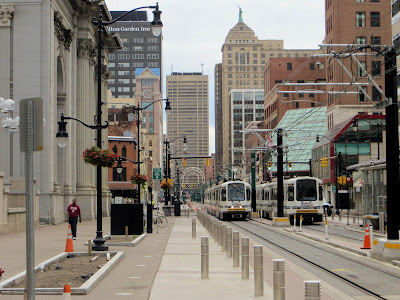For many years, US transit agencies have run a lot of service at rush hour and comparatively little outside of rush hour. The 9 am to 5 pm commuter has been king since the 1950’s when most private transit companies were purchased by local governments. And that approach has attracted generations of commuter riders. But in many countries, people going to and from work are only part of their ridership. Instead, they run frequent service at all hours to attract other trips such as people running errands, visiting friends and family, or going out on the town. Frequent service means that people traveling outside of rush hour do not have to wait for a train or even check schedules. In fact in Moscow, the Metro authorities do not even publish schedules and instead tell their drivers to follow the train in front of them by 1.5-3 minutes. Running more service is a key reason by other countries attract far more riders than their US counterparts.
 |
| From David Wilson, 20150827 61 NFTA Light Rail @ Fountain Plaza |
Buffalo Metro Rail runs just 4 trains per hour in off-peak hours and 6 during rush hour. Still, the system attracts about 13,700 riders per weekday and while many have criticized its short length and lack of development near many stations, it’s per-mile ridership is reasonably good compared to US other systems. The low level of frequency requires just 6 trainsets for service, at peak hours 18 railcars out of 27 in its fleet. Typically, three cars are undergoing maintenance and one serves as a spare so NFTA could run up to 23 cars but rarely does except for special events. By running less service, Metro Rail is in effect not using its most expensive assets to its full potential.
Adding more service would attract more riders because waiting times would be significantly reduced and the transfer penalty or time cost of transferring from a bus and waiting for the next Metro Rail train would also decline, both of which make the service more attractive for riders. Instead of waiting an average of 5 minutes at rush hour and 7.5 minutes midday, more frequent service would reduce that time to an average of 3 minutes.
I propose running 10 trains per hour throughout the entire day, using 5 three-car train sets and 4 two-car trainsets which retains the current spare and maintenance ratio of 4 to 27. Increased use of the cars will likely increase wear and tear costs but the cars were recently rehabbed and are getting close to the end of their useful lives, requiring replacement in the next decade or so. See sample schedule.
While Metro Rail would not need to immediately buy new trainsets to run additional service, the key cost increase would be labor. Working with the train driver's union to increase the number of segments each driver operates during their shift could lower the per hour operating cost while still requiring more drivers than today. In addition, driver productivity is increased because train drivers will have shorter times to turn around a train, in some cases as lower as 3 minutes compared to 15-20 minutes today. Funding this dramatic service increase will certainly increase operating costs but this will be offset by increased fare revenue from additional passengers.
With planning for an expansion to the suburbs underway, it will be helpful for authorities to demonstrate increased ridership through better use of existing assets. Why not run more Metro Rail trains?
No comments:
Post a Comment